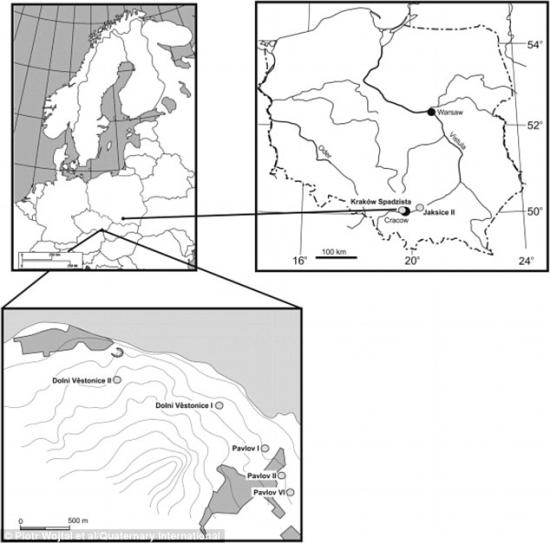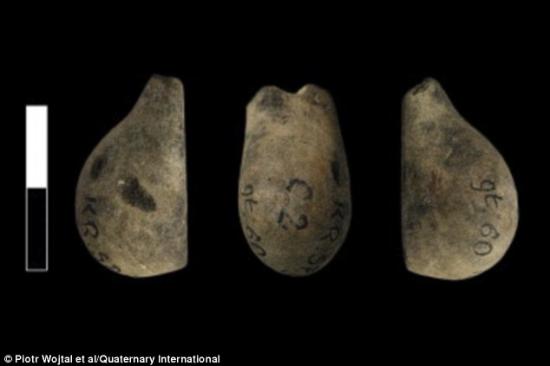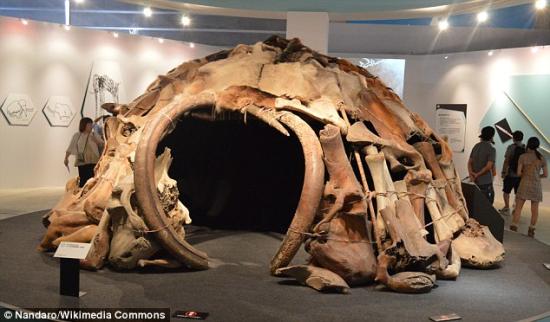Gravettian people gorged on roasted meat and used bones as fuel
Richard Gray
Source - http://www.dailymail.co.uk/sciencetech/article-3116633/Did-early-Europeans-wipe-mammoth-Gravettian-people-gorged-roasted-meat-used-bones-fuel-study-reveals.html#ixzz3cbCe2eNa
Archaeologists have concluded mammoths were major part of human diet
They were Ice Age giants that dominated the landscape of Europe and Asia for hundreds of thousands of years before disappearing relatively suddenly.
Now scientists believe they may have pinpointed one of the main causes for the extinction of the woolly mammoth – human hunters that feasted on their flesh and used their leftover bones as fuel.
Researchers have long suspected that humans helped drive mammoths to the brink of extinction, but the new research shows one group of people exterminated the animals on an industrial scale.
 Researchers at the Polish Academy of Sciences examined mammoth bones found at several Gravettian sites in central and Eastern Europe and found evidence for extensive butchery, like the cut marks on the bone above. They conclude woolly mammoths formed an important part of these prehistoric hunters' diet
Researchers at the Polish Academy of Sciences examined mammoth bones found at several Gravettian sites in central and Eastern Europe and found evidence for extensive butchery, like the cut marks on the bone above. They conclude woolly mammoths formed an important part of these prehistoric hunters' diet
Archaeologists have found evidence that the Gravettian culture – a group of hunter gatherers who lived in central and Eastern Europe between 30,000 and 20,000 years ago – were specialised mammoth hunters.
They claim that these people not only ate meat from the giant animals but they also used bone fragments as fuel for their fires.
Bones and ivory were also an important raw material for making tools and ornaments such as jewellery while in some cases they also used mammoth bones to construct dwellings.
Dr Piotr Wojtal, an archaeologist at the Institute of Systematics and Evolution of Animals at the Polish Academy of Sciences in Krakow, said the Gravettian people appeared to roast the mammoth meat.
He said: 'Mammoth remains have been found at many Central European Gravettian open air sites.
'At some of them the numbers of mammoth remains and counts of individuals are very large, indicating a clear hunting specialisation among the human societies of this culture.
'This giant mammal certainly played a very important role in the everyday life of Gravettian hunter-gatherers.
'Woolly mammoths provided both meat and raw materials for the production of bone tools, weapons, ornaments, portable art, and also for dwelling construction in some sites.
'The importance of this animal is underlined by the presence of mammoth sculptures made from ivory.
'Fragmented mammoth bones were frequently used by Gravettian people as fuel for camp fires.
The researchers, whose work is published in the journal Quaternary International, examined mammal bones found at five different sites in Poland and the Czech Republic, which had been inhabited by Gravettian people.
 Gravettian hunter-gatherers living in central and eastern Europe appeared to prey particularly on woolly mammoths, according to the new research. A reconstruction of early humans attacking a mammoth is shown
Gravettian hunter-gatherers living in central and eastern Europe appeared to prey particularly on woolly mammoths, according to the new research. A reconstruction of early humans attacking a mammoth is shown
 The researchers examined bones found at several sites in the Czech republic and Poland, as shown above
The researchers examined bones found at several sites in the Czech republic and Poland, as shown above
They found over all that mammoth bones account for five to 18.2 pre cent of all mammalian individuals found at these sites
At some sites the remains of a few dozen mammoths have been discovered while the remains of just a single individual of other herbivores was found.
They found many of the mammoth bones had cut marks and signs of chopping that appear to have been made during skinning and butchering of the giant creatures.
Burnt bone fragments that appear to be from mammoths were also found at the different sites. The researchers say as these appear to have been broken before burning, it is likely they were being used as a fuel source.
At many of the sites pendants, rings and shovel like spatulas were found made from pieces of mammoth bone or ivory.
In one case at a site in Pavlov in the Czech Republic, a long tusk from a woolly mammoth had been carefully polished while in other Gravettian sites figurines made from ivory have also been found.
 Some of the bones showed signs of having being broken and burned. This pendant was also discovered and showed signs of burn marks, although the scientists believe in this case they may have been accidental
Some of the bones showed signs of having being broken and burned. This pendant was also discovered and showed signs of burn marks, although the scientists believe in this case they may have been accidental
 This reconstruction of a shelter built from mammoth bones is based on those found close to Mezhyrich in the Ukraine. The authors of the new study say such uses show how important mammoth's were as a prey
This reconstruction of a shelter built from mammoth bones is based on those found close to Mezhyrich in the Ukraine. The authors of the new study say such uses show how important mammoth's were as a prey
In some cases, particularly on the plains of Russia and Ukraine, mammoth bones were as a building material for dwellings.
The Gravettians were a Stone Age culture known for making small pointed blades who lived across much of Europe.
Remains of this prehistoric culture have been found in caves in southern France and more open sites on the plains of Central Europe and Russia.
Isotopic studies of human remains from the Czech Republic have also revealed that mammoths formed a large part of the Gravettian diet.
Dr Wojtal and his colleague Jaroslaw Wilczynski say it appears the success of this prehistoric human culture relied heavily on woolly mammoths.
Woolly mammoths are thought to have first evolved around 400,000 years ago before dying out around 10,000 years ago.
While humans have been blamed for causing them to go extinct in the past, there has a been a great deal of debate about how much of an impact human hunters could have had.
Writing in the journal, Dr Wojtal and Dr Wilczynski said it seems likely the Gravettian humans played a major role in driving woolly mammoths to extinction.
They said: 'We suggest that human specialization in hunting woolly mammoths was due to the desire to obtain large amounts of meat in a very short time.
'Not only were mammoth bones a desirable resource as fuel, but also bones and ivory were used as an important raw material for the production of tools, ornaments, and portable art objects.'